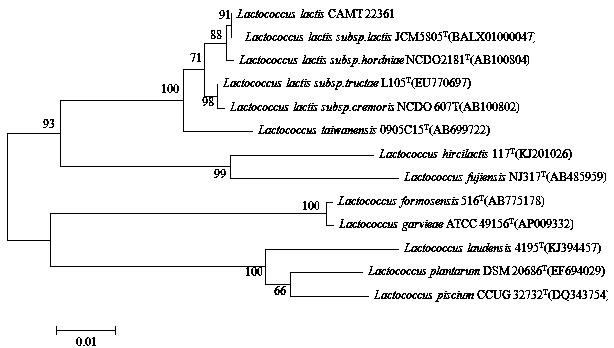A Strain of Lactococcus lactis CAMT22361 Degrading t-2 Toxin
A technology of CAMT22361 and Lactococcus lactis, applied in the direction of bacteria, microorganism-based methods, microorganisms, etc., can solve the problems of secondary pollution, chemical reagent residues, etc., and achieve good application prospects
- Summary
- Abstract
- Description
- Claims
- Application Information
AI Technical Summary
Problems solved by technology
Method used
Image
Examples
Embodiment 1
[0017] Example 1: Isolation and identification of strains
[0018] Isolation of lactic acid bacteria: Rinse the surface of sandworms with sterilized seawater, dry them, weigh 25g of intestinal samples and cut them into pieces. Diluted by 10-fold dilution method, and spread on MRS solid medium containing 1.5% calcium, observed after culturing at 25 °C for 3-5 days, picked the colonies with calcification circles, purified, and then carried out Gram staining. and catalase test. Gram-positive and catalase-negative strains were identified as lactic acid bacteria, and slanted was stored.
[0019] Screening of lactic acid bacteria degrading T-2 toxin: inoculate the isolated lactic acid bacteria into the modified MRS liquid medium containing 50 ng T-2 toxin per ml, (modified MRS medium formula g / L: peptone 10 g, beef extract 10g, K 2 HPO 4 2g, Diammonium Citrate 2g, Sodium Acetate 5g, Glucose 20g, Tween-80l mL, MgSO 4 ·7H 2 O 0.58g, MnSO 4 ·4H 2 O0.25g, distilled water 1000mL,...
Embodiment 2
[0024] 1. Activation of Lactococcus lactis CAMT22361
[0025] In an ultra-clean operating table, the above-mentioned Lactococcus lactis CAMT22361 was picked and inoculated into the MRS liquid medium (pH 6.2-6.4) improved in Example 1, and cultivated in a shaking table at 37°C for 24 hours to obtain an activated bacterial liquid.
[0026] 2. Inoculation of fermentation broth
[0027] In an ultra-clean operating table, take a certain amount of activated bacterial solution, centrifuge at 10,000 r / min for 2 min, discard the supernatant, wash the pellet with sterile saline twice, and resuspend to the original volume. Use sterile water as a blank control to measure OD. 600 nm, and diluted to absorbance value of 0.3 with sterile physiological saline to prepare bacterial suspension, and inoculated the bacterial suspension on the modified MRS liquid medium at an inoculum of 1%, so that the initial bacteria in the broth medium were The number is about 10 8 CFU / mL.
[0028] 3. Addit...
Embodiment 3
[0047] Example 3: Degradation effect of Lactococcus lactis CAMT22361 on T-2 toxin in feed of Penaeus vannamei
[0048] 1. Preparation of Lactococcus lactis CAMT22361 bacterial suspension
[0049] In an ultra-clean operating table, pick Lactococcus lactis CAMT22361 stored on a slanted surface and inoculate it in MRS broth medium, and cultivate at 37°C for 24-28 hours, so that the final concentration of the bacterial suspension reaches 10 8 CFU / mL.
[0050] 2. Preparation of T-2 toxin venom
[0051] Accurately weigh 1 mg of T-2 toxin standard (Enzo, USA, purity ≥ 98%), dissolve it in acetonitrile, dilute to 1 mL, and prepare 1 mg / mL T-2 toxin venom.
[0052] 3. Preparation of poisonous bait for Penaeus vannamei
[0053] Prawn basic feed (33% imported fish meal, 4% squid meal, 18% soybean meal, 8% peanut meal, 4% shrimp bran, 1% mineral premix, 22% high-gluten flour, 1% fish oil, 3% soybean lecithin %, premix 5.7%, multivitamin 0.3%, crushed until all feeds pass through a 40-...
PUM
 Login to View More
Login to View More Abstract
Description
Claims
Application Information
 Login to View More
Login to View More - R&D
- Intellectual Property
- Life Sciences
- Materials
- Tech Scout
- Unparalleled Data Quality
- Higher Quality Content
- 60% Fewer Hallucinations
Browse by: Latest US Patents, China's latest patents, Technical Efficacy Thesaurus, Application Domain, Technology Topic, Popular Technical Reports.
© 2025 PatSnap. All rights reserved.Legal|Privacy policy|Modern Slavery Act Transparency Statement|Sitemap|About US| Contact US: help@patsnap.com


